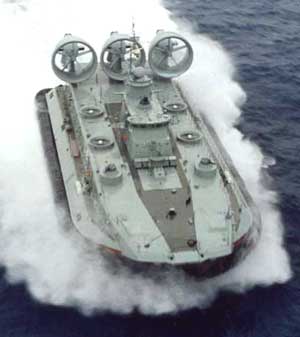|
 |
|
Project 1232.2 Zubr Pomornik class Amphibious landing craft

The Zubr (Bison) Air Cushion Landing Craft, known by the NATO codename
Pomornik [Skua], came into service in 1986. At that time it was the
world's largest air-cushion vehicle [a title later claimed by the Project
1239 Sivuch/Bora class Guided Missile Corvette]. The mission of the
ships is to carry out rapid sea-lift and beach landing of assault troops
and combat material on territory held by hostile forces. The ships also
provides fire support for the troop operations on shore. The ships are
capable of laying active minefields.
The ships are equipped with two stabilised multiple rocket launchers,
four Igla-1M portable air defence missile systems, and two AK-630 30
mm automatic gun mounts. The Zubr Class ships can carry up to 130 tons
of cargo: three medium battle tanks such as the T-80B tank, or eight
BMP-2 infantry combat vehicles, or ten BTR-70 armoured personnel carriers,
or 360 fully equipped amphibious landing troops. The ships have a bow
and a stern ramp for fast landing of troops and combat material. The
ships have a top speed of 60 knots. It can move on sea surface, sandbanks,
marshes and overcomes obstacles up to 2 meters.
The high-temperature gas-turbine engines are installed on the craft
to drive the air-cushion blowers and air propellers. Four NO-10 blowers,
fitted with axial operating wheels, 2.5 m in diameter, are mounted to
generate the air-cushion. The air thrust for movement is provided by
three four-bladed reversible variable-pitch air propellers, 5.5 m in
dia. The air propellers are mounted inside ring shrouds. The craft is
equipped with two electric power plants. Each electric power plant comprises
two gas-turbine generators, rated at 100 kW each, as well as the main
switchboards. Control of the craft and its technical means is centralized,
remote, automated. These modes of control are celected from the main
control station, central control room and remote control panels.
The square-shape pontoon constitutes the main carrying structure of
the hull, which ensures the ruggedness and insubmersibility of the craft.
The pontoon's superstructure is divided by two longitudinal bulkheads
into three functional parts. The middle part accommodates a compartment
for armored vehicles to be landed with taxi tracks and loading/unloading
ramps. The main and auxiliary powerplants, troop compartments, crew
living quarters, as well as the life-support system and the system for
protection against WMD. To maintain comfortable conditions at combat
stations, in amphibious troops compartments and crew living quarters,
provision is made for ventilation, air-conditioning and heating systems,
thermosound insulation coatings and structures made from vibro-damping
materials. Provision is also made for the normal rest and feeding of
the crew.
Apparently some ten units were built between 1986 and 1994. Of these,
one was completed for Ukraine and three additional units were tranferred
to Ukraine. The design is believed to be rather unreliable, and the
standard engine lifetime of 500 hours is said to diminish to 50 hours
when the payload is increased from one to three tanks. The six remaining
Russian units are generally believed to remain in service, though some
may be inoperable or in reserve. Reportedly the Greek Navy intends to
buy two from the Russian Navy and two more that would be built in Ukraine.
In the early 1990s two units were cancelled and scrapped incomplete.
The disposition and chronology of specific units is conjectural.
On 25 May 2000 a ZUBR air-cushion landing craft was laid down at ALMAZ
Shipbuilding Company. The contract for delivery of this craft was signed
with Hellenic Ministry of Defense. on 24 October 2000 Almaz Shipbuilding
Company launched the first of two air-cushion landing crafts ZUBR project
that are under building for Hellenic Navy.
From GlobalSecurity.org
|
|
 |
|